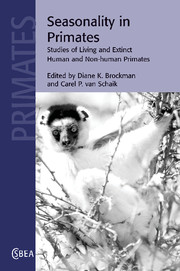Book contents
- Frontmatter
- Contents
- List of contributors
- Preface
- Part I Introduction
- Part II Seasonal habitats
- 2 Tropical climates and phenology: a primate perspective
- Part III Seasonality and behavioral ecology
- Part IV Seasonality, reproduction, and social organization
- Part V Seasonality and community ecology
- Part VI Seasonality and human evolution
- Index
- References
2 - Tropical climates and phenology: a primate perspective
Published online by Cambridge University Press: 10 August 2009
- Frontmatter
- Contents
- List of contributors
- Preface
- Part I Introduction
- Part II Seasonal habitats
- 2 Tropical climates and phenology: a primate perspective
- Part III Seasonality and behavioral ecology
- Part IV Seasonality, reproduction, and social organization
- Part V Seasonality and community ecology
- Part VI Seasonality and human evolution
- Index
- References
Summary
Introduction
The order Primates is one of the few mammalian orders that are confined largely to the tropics (Richard 1985): only a few cercopithecines are found outside the tropics. Thus, the great majority of primate species live in tropical forests and woodlands, with a small minority inhabiting the open savanna.
Our aim here is to explore phenology, the production of young leaves (“flush”), flowers, and fruit, of woody plants in these prime primate habitats to seek useful generalizations for the primate ecologist. Despite the remarkable variability in phenological activity patterns of individual species (e.g. Newstrom et al. 1994; Sakai et al. 1999), there is enough between-species synchrony to distinguish clear patterns in tropical phenology that should be helpful to predict the responses of non-specialist primate consumers to fluctuations in food availability. This chapter should thus provide a general backdrop for the more detailed studies of the responses of primate consumers to changes in the availability of their various food items presented in subsequent chapters.
Specifically, we present the results of a meta-analysis of studies of phenology of plant communities of tropical forests and woodlands, many of them produced by primatologists in the course of their fieldwork. We explore the extent to which we can distinguish clear relationships between phenology and the timing of climatic events, the extent to which climatic seasonality is translated into phenological seasonality, and the temporal relationship between the fluctuations in availability of flush and ripe fruit. We also explore interannual variation in phenology.
- Type
- Chapter
- Information
- Seasonality in PrimatesStudies of Living and Extinct Human and Non-Human Primates, pp. 23 - 54Publisher: Cambridge University PressPrint publication year: 2005
References
- 56
- Cited by



